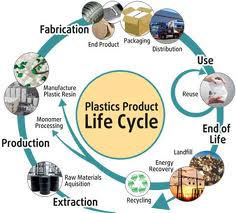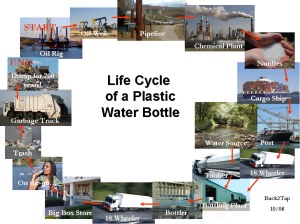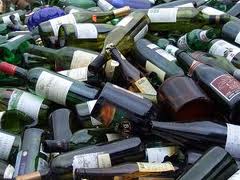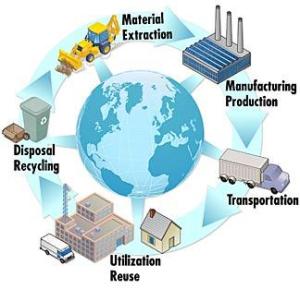Life Cycle Assessment (LCA) is a means to assess the ecological footprint:
– at every stage in the product’s life;
– by studying all environmental impacts generated
(CO2 emissions, energy and water consumption, air pollution,…)
LIFE CYCLE STAGES:
The Life Cycle Assessment then makes it possible to
eco-innovate, i.e. create new glazing products, even
more planet-friendly, from design stage to disposal.
Life Cycle Assessment of Plastic:

Plastic bags were first introduced in 1977 and now account for four out of every five bags handed out at grocery stores.
Biodgredation/Compostability:
• While certain plastics may be biodegradable or compositable in specially designed industrial facilities, evidence indicates that this feature may be of little value in the effort to reduce waste.
• Compositable plastics, which are produced from plant- based feedstocks, do not degrade in landfills too.
• In order to breakdown as intended, compostable plastics must be sent to an industrial or food composting facility, rather than to backyard piles or municipal composting centers.
• By definition, composting and biodegradation release carbon dioxide (CO2), a greenhouse gas, into the atmosphere, increasing the potential for climate change.
Recycling can help save resources, its real value lies in the reduction of greenhouse gas emissions, and the minimization of waste going to landfills. Also, recycling helps reduce litter, as bags are contained and stored.
Assessment of Environmental Impacts of plastic manufacturing and benefits of plastic products:
As an energy-intensive manufacturing process, it is no surprise that the primary environmental impacts associated to plastic manufacturing are the Global Warming Potential (mainly due to CO2 emissions from raw materials) and Primary Energy Demand (for which the upstream production of energy, in particular natural gas, is the main contribution).
Consumer Use:
• Consumers tend to fly through sets of these plastic cups. Since they are one time use items they do not last very long.
• Everyone has seen the huge amounts of cups at parties and how many end up in the trash
Recycling:
• Sorted
• Shredded
• Cleaned
• Resin
• Shipped
Disposal:
• 50-250 years
• Sanitary landfill – landfill that uses a clay liner to isolate the trash from the environment.
• Municipal solid waste (MSW) landfill – uses a synthetic (plastic) liner to isolate the trash from the environment.
Life Cycle Assessment of Glass:
Life Cycle Assessment (LCA) provides the best framework to assess and determine the environmental impacts of products. As such it helps orientate improvements towards even greater sustainability. Complete LCA analysis take account of the environmental impact of manufacturing products but also the impacts and benefits of products in their use phase as well as their recyclability at their end-of-life.
The main manufacturing processing activities taking place at the manufacturing site are the batch preparation, the melting of the raw materials in the furnace, the formation of a glass ribbon in the bath of molten tin, the conditioning in the annealing lehr, the quality control, automatic cutting and storage.
Key Environmental Concerns about Glass
One of the primary findings of the LCA is the relatively small energy impact resulting from transportation of glass packaging within the full scope of the environmental life cycle of glass. Transportation of raw materials and cullet used in glass production represents less than 10 percent of the total energy used in the production of container glass. Even at current industry recycled content rates, it is clear that the transportation emissions are offset by the energy savings gained from the use of recycled glass in the manufacturing process.
The CO2 savings from glass recycling are as large, or larger, than the transportation emissions.
Why Recycling is Good for Industry and the Environment:
Recycling glass containers provides for unmatched
production efficiencies and significant environmental
benefits: decreases the amount of raw materials used,
lessens the demand for energy, cuts CO2 emissions,
extends furnace life without any processing by-products
and saves on overall manufacturing costs.
Making Glass
The glass container industry is very diverse and covers a variety of different types of technology to produce glass bottles and jars.
Container glass begins with melting together several largely naturally occurring minerals. The most common raw materials used to produce glass are:
• Cullet (recycled glass)
• Silica sand
• Soda ash (brings down melting temperatures)
• Limestone (enhances durability)
• Materials can be added to produce different colors
Container glass furnaces are generally designed to melt large quantities of glass over a continuous period of more than 20 years and range in output from 150 tons of glass per day to over 600 tons of glass per day.
Materials are heated to 2350 °F at a constant temperature and the glass gob cools slowly to a working temperature around 2150 °F. Then the glass goes through a two-stage molding process by using either the press-and-blow or the blow-and-blow techniques.
The stages for this are:
1. Obtain a gob of molten glass at the correct weight and temperature
2. Form the primary shape in a first or blank mold by pressure from compressed air or metal plunger
3. Transfer the primary shape into the final mold
4. Complete the shaping process by blowing the container with compressed air to the shape of the final mold
5. Remove the finished product from the post forming process
Glass: The Perfect Cycle:
1. The new glass packaging is filled with product
and distributed through retail outlets.
2. The product is purchased by consumers & consumed.
3. Containers are collected through curbside,
drop-off centers, and commercial on-premises
locations.
4. Recovered glass packaging is crushed into
cullet and used as raw material to make new
glass packaging.
5. Virgin raw materials are added as needed to
the mix for new packaging.
6. The raw material is formed into new glass
packaging.
Glass container manufacturers continue to look for ways to strengthen glass, through new surface treatments and better designs, without sacrificing the improvements in material reduction. Improvements in coating technologies have helped to make glass more durable and versatile for consumer use.






